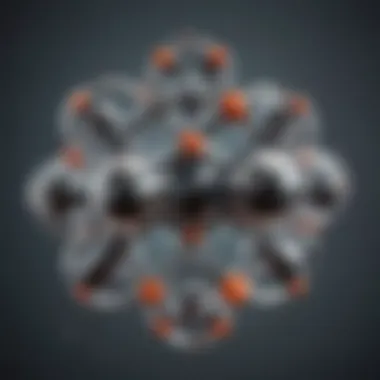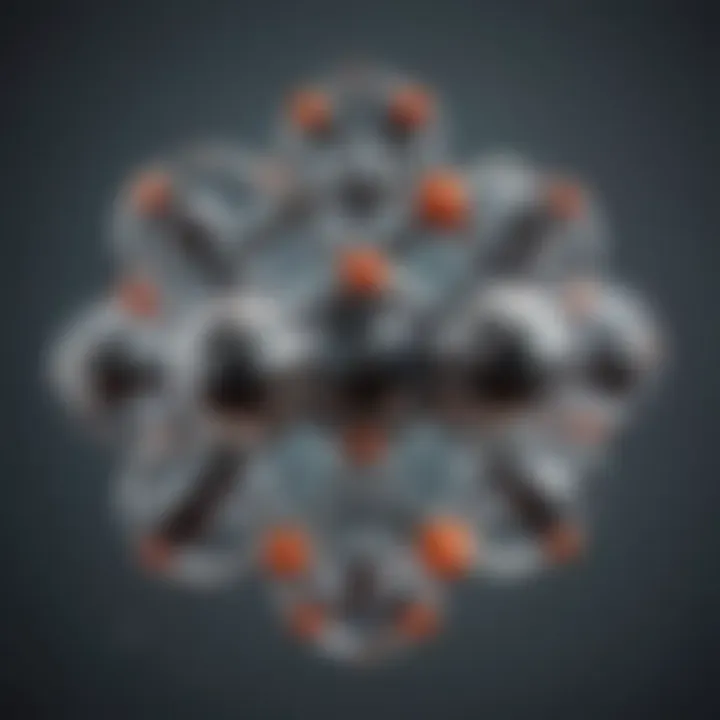Hydroxyethyl Methacrylate: Properties and Applications


Intro
Hydroxyethyl methacrylate (HEMA) is a compound that plays a critical role in a plethora of industries and research arenas. With its unique chemical structure, HEMA is prized for its versatility, making it a go-to ingredient in various applications ranging from commercial coatings to sophisticated biomaterials. This compound stands out due to its ability to undergo polymerization, which allows it to form robust networks that have myriad practical uses.
One key aspect of HEMA that sets it apart is its blend of polyfunctional properties. It can dissolve in water, unlike many methacrylate monomers, which opens up avenues for its use in aqueous systems, particularly in the development of adhesives and certain hydrogels. Businesses and researchers alike recognize its potential, leading to growing interest and ongoing advancements in its applications.
The discussion surrounding HEMA includes not just its chemical composition, but also how it’s synthesized and the environmental considerations involved in its usage. By piecing all this information together, the narrative surrounding hydroxyethyl methacrylate provides invaluable insights into both its scientific and practical implications.
Research Overview
Key Findings
Recent investigations into hydroxyethyl methacrylate have revealed several groundbreaking observations:
- Versatility in Applications: HEMA's application extends beyond traditional fields, with its presence noted in innovative sectors such as tissue engineering and drug delivery systems.
- Synthesis Processes: Various synthesis methods have been explored, emphasizing the importance of optimizing conditions to enhance yield and purity, crucial for industrial applications.
- Environmental Concerns: Studies indicate the potential environmental impacts of HEMA use, especially relating to waste management and its biodegradability.
Study Methodology
The studies examining HEMA typically employ a mix of experimental and analytical approaches. Laboratory syntheses are conducted to establish optimal reaction conditions, while analytical techniques like spectroscopy aid in characterizing the resultant compounds. Additionally, surveys and case studies in industrial settings help to underpin the practical applications and challenges faced with HEMA today. This unique combination allows for a nuanced understanding of both the material properties and its performance in real-world applications.
Background and Context
Historical Background
The history of hydroxyethyl methacrylate is rooted in early polymer chemistry, with initial investigations occurring in the mid-20th century. Since then, HEMA has evolved significantly.
Current Trends in the Field
In contemporary research, there is a push towards greener synthesis methods, minimizing the environmental footprint of HEMA production. Also, increasing focus is being placed on its use in biocompatible materials, making HEMA a key player in the development of medical devices and regenerative medicine. Folding this into its broad spectrum of applications including coatings, adhesives, and drug delivery systems, HEMA remains at the forefront of material science research.
"Hydroxyethyl methacrylate is not just a compound; it’s a cornerstone of innovation in material science."
In an era of rapid technological advancement, understanding the properties, synthesis, and application of hydroxyethyl methacrylate becomes ever more crucial, both academically and commercially. This article endeavors to elucidate these aspects, providing a comprehensive guide that intertwines the compound's scientific complexity with its practical utility.
Foreword to Hydroxyethyl Methacrylate
Hydroxyethyl methacrylate, often abbreviated as HEMA, is a compound that stands out for its versatility across various fields. Whether you’re talking coatings, adhesives, or biomaterials, HEMA often plays a pivotal role. Understanding this compound becomes increasingly crucial not just for specialists but for anyone involved in industries that utilize polymers. By dissecting Hydroxyethyl Methacrylate, this article aims to highlight its significance, applications, and properties in a structured manner.
Chemical Structure and Formula
The chemical structure of Hydroxyethyl Methacrylate is rather telling of its functionality. Its formula is C₆H₁₀O₃, which indicates a methacrylic acid backbone combined with a hydroxyethyl functional group. This configuration allows HEMA to engage effectively in polymerization reactions, influencing its properties as a monomer.
The hydroxy group contributes to the hydrophilicity of the compound, offering solubility in water and enabling it to interact favorably in various formulations. This unique structure not only contributes to its polymer attributes but also plays a role in its utilization in adhesive and coating systems.
Historical Context and Development
Hydroxyethyl Methacrylate’s journey began back in the mid-20th century, marking an era where advances in polymer science were significantly gaining momentum. Initially developed to enhance the properties of acrylic polymers, HEMA quickly found its way into commercial applications.
As industries demanded more robust materials, the development and synthesis techniques for HEMA evolved. This evolution hasn’t been without challenges. Early methods of synthesis were often hindered by solubility issues and stability concerns. However, the ingenuity of chemists led to the refinement of synthesis methods that are now more efficient, yielding higher purity and versatility of the product. Today, ongoing research constantly refines our understanding and application of HEMA, ensuring it continues to adapt to the ever-changing demands of industries.
Hydroxyethyl Methacrylate has emerged over time as a vital chemical for manufacturers, researchers, and healthcare professionals alike. Its development reflects not only scientific pursuit but also commercial evolution.
Physical and Chemical Properties
Understanding the physical and chemical properties of hydroxyethyl methacrylate (HEMA) is essential, as they play a pivotal role in its various applications. HEMA's unique characteristics directly influence its behavior in formulations and its effectiveness in different environments. Thus, insights into properties like solubility, stability, and thermal performance can guide developmental processes and end-user satisfaction.
Solubility and Stability
Hydroxyethyl methacrylate is a colorless, viscous liquid that exhibits notable solubility in water as well as organic solvents. This dual solubility is a boon for formulators, allowing it to be easily incorporated into water-based systems. Its compatibility with various solvents is particularly valuable when considering applications in coatings and adhesives where versatility and ease of application are critical.
"Solubility can be the difference between a product sticking or just slipping away."
Stability also remains a hallmark of HEMA’s profile. Under standard conditions, HEMA shows a remarkable resistance to hydrolysis. This stability is essential for products requiring extended shelf life, particularly in the coatings industry. However, care must be taken when exposed to heat and UV light, which can degrade the compound over time. Understanding these stability parameters helps in designing products that can withstand various environmental factors.
Thermal and Mechanical Properties


When it comes to thermal and mechanical properties, hydroxyethyl methacrylate showcases a balance of flexibility and strength that is quite remarkable. The glass transition temperature of HEMA-based polymers generally hovers around the low to mid-temperatures. This means that while materials made from HEMA can exhibit good flexibility at room temperature, they can become brittle at lower temperatures, which may not always be desirable, especially for applications involving extreme conditions.
Moreover, HEMA's mechanical strength is bolstered when used as part of copolymer formulations. The presence of other monomers can enhance properties like toughness and elasticity. This combination often results in materials that not only meet but exceed performance expectations across diverse application areas:
- Adhesives that maintain bond strength under varying conditions.
- Coatings that resist wear and tear while providing smooth finishes.
- Biomedical applications where flexibility and biocompatibility are paramount.
Great attention should be afforded to these properties during the design processes of HEMA-based products to maximize their effectiveness and reliability. Clearly, the physical and chemical properties of hydroxyethyl methacrylate are not merely academic; they are integral to its application across various fields.
Synthesis of Hydroxyethyl Methacrylate
The synthesis of hydroxyethyl methacrylate (HEMA) is a crucial segment of the conversation surrounding this compound. Understanding how HEMA is made provides insight into its functional attributes and broadens the horizon for potential applications. Different methods of synthesis present various benefits, resulting in comprehensive accessibility and usability in industries ranging from coatings to biomaterials. Each method has its nuances, which can significantly influence product efficiency and quality.
Common Synthesis Methods
There are several common methods to synthesize hydroxyethyl methacrylate, which have evolved over time based on industrial need and technological advancements. Here, we delve into three prevalent techniques: free radical polymerization, emulsion polymerization, and solvent-free methods.
Free radical polymerization
Free radical polymerization is one of the most traditional pathways for producing HEMA. It involves the initiation of a reaction by free radicals, which then propagate the polymer chain. This process is beneficial largely because it allows for the creation of polymers that have diverse molecular weights and properties.
A key characteristic of free radical polymerization is its ease of use; it often requires relatively simple reaction conditions and commonly available reagents. However, the unpredictable nature of radical reactions can lead to the formation of various side products, which may complicate purification.
Despite its drawbacks, the simplicity and reliability of this method have kept it popular in various sectors. In the context of HEMA, its unique feature lies in the control it affords over the molecular weight, which can influence the material properties.
Emulsion polymerization
Emulsion polymerization is another widely implemented technique that stands out for its efficiency and effectiveness in yielding high molecular weight polymers. This method occurs through the formation of a stable emulsion of monomer droplets dispersed in water.
One of the central advantages of emulsion polymerization is its capacity to produce materials with greater stability and reduced viscosity during the reaction. This key characteristic allows for the manipulation of the polymerization process, resulting in better polymer characteristics for end-use applications.
However, it can be more complex than free radical methods. Careful control of conditions such as surfactant concentrations and temperature is necessary to prevent issues like coagulation. Still, the efficiency and scalability of emulsion polymerization make it a prominent choice for synthesizing HEMA.
Solvent-free methods
Solvent-free methods represent an innovative approach, emphasizing sustainability by eliminating the need for hazardous organic solvents. This synthesis pathway typically utilizes thermal energy to facilitate the polymerization process, which can greatly reduce environmental impact.
A salient feature of solvent-free methods lies in their environmentally friendly nature, allowing for lower waste production and decreased toxicity risks. This attribute aligns well with the growing emphasis on green chemistry in contemporary research and manufacturing practices.
On the flip side, one of the challenges associated with solvent-free synthesis can include heat management; excessive temperature gradients might lead to unwanted thermal decomposition of the reactants. Nonetheless, the increasing focus on sustainability lends added value to the solvent-free approach in the HEMA synthesis narrative.
Key Reaction Conditions
When synthesizing hydroxyethyl methacrylate, key reaction conditions play a crucial role in determining the success and efficiency of the process. Factors such as temperature, pressure, and catalyst type can markedly affect not only the yield but also the polymer's ultimate properties.
- Temperature Control: Elevated temperatures might facilitate faster reactions but can also result in unwanted side reactions. Conversely, too low temperatures can inhibit polymerization altogether.
- Pressure Considerations: In certain methods, particularly in emulsion or free radical polymerization, maintaining appropriate pressure is vital to ensure the stability of the reaction medium.
- Catalyst Selection: The choice of catalyst or initiator influences the rate of polymerization as well as the final characteristics of the polymer. A well-chosen catalyst can improve both the efficiency of the reaction and the quality of the product.
Understanding these conditions allows researchers and manufacturers alike to tailor processes to suit specific needs, enhancing the versatility of hydroxyethyl methacrylate in various applications.
Applications in Various Industries
Hydroxyethyl methacrylate (HEMA) plays a crucial role across several industries, showcasing its versatility and utility in a variety of applications. Its unique chemical properties, such as excellent adhesion and compatibility with a range of materials, make it an indispensable component in formulations for coatings, adhesives, and biomaterials. As industries strive for better performance and sustainability, HEMA emerges as a compelling choice, potentially replacing older, less efficient compounds.
Use in Coatings and Adhesives
In the realm of coatings and adhesives, hydroxyethyl methacrylate is celebrated for its outstanding performance. Its incorporation into polymer matrices significantly enhances the adhesion qualities and mechanical strength of these products. This enhancement can be particularly crucial in industries that require durable and resilient coatings, including automotive and construction.
- Key Benefits:
- Excellent adhesion to various substrates, such as metals and plastics.
- Improved resistance to solvents and environmental degradation.
- Enhanced flexibility while maintaining firmness, reducing the risk of cracking.
HEMA-based coatings can provide a transparent finish, making them ideal for aesthetic applications as well. As industries look for more sustainable solutions, utilizing HEMA also allows for lower levels of volatile organic compounds, aligning with global efforts to promote eco-friendly practices.
Role in Biomaterials and Medical Devices
When it comes to biomaterials and medical devices, hydroxyethyl methacrylate has earned its stripes. Its biocompatibility, which is the ability to coexist with biological systems without eliciting adverse reactions, makes HEMA a prime candidate for several medical applications.


Prominent uses include:
- Dental materials: HEMA is often found in dental adhesives and composites, contributing to improved bonding to tooth structures.
- Contact lenses: Soft contact lenses frequently contain HEMA, providing comfort and hydration due to its high water retention capacity.
- Drug delivery systems: HEMA facilitates the creation of hydrogels that can release pharmaceuticals at controlled rates.
"The benefits of hydroxyethyl methacrylate in medical applications emphasize its importance in enhancing patient outcomes and advancing medical technology."
Applications in Consumer Products
In the consumer products arena, hydroxyethyl methacrylate is found in a multitude of everyday items. From cosmetics to household items, HEMA's properties lend themselves well to products that require gloss, durability, and moisture resistance.
Some areas of application include:
- Cosmetics: HEMA is often used in skincare formulations, enhancing the texture and moisture retention of creams and lotions.
- Household cleaners: Its chemical properties help in the formulation of effective cleaning agents that can maintain surface integrity while providing thorough cleaning.
- Textile coatings: HEMA is utilized in some clothing treatments to provide water-resistance and durability, catering to consumer preferences for functional fabrics.
The adaptability of hydroxyethyl methacrylate in these diverse applications reflects its broad utility, underscoring its essential role in modern consumer products.
Polymerization Mechanisms
Understanding the polymerization mechanisms of hydroxyethyl methacrylate is essential, as they play a central role in determining the properties and applications of the resultant polymers. The way in which the polymer chains are formed affects everything from the physical characteristics such as strength and flexibility to how the material interacts with other substances. Thus, a solid grasp of these mechanisms can lead to enhanced innovation in material design, tailored applications, and improved sustainability practices.
Initiation and Propagation Steps
The initiation phase in the polymerization of hydroxyethyl methacrylate occurs when initiators, often free radicals, start the chain reaction. These radicals may come from various sources, including chemical initiators like benzoyl peroxide or can be generated through photoinitiation methods. When an initiator interacts with a monomer of hydroxyethyl methacrylate, it generates a new radical, leading to the eventual formation of a polymer chain. This initial step is crucial as it lays the groundwork for the propagation that follows.
During propagation, the growing polymer chain reacts repeatedly with more methacrylate monomers, rapidly adding them to the end of the chain. This repetitive process is what transforms small molecules into long, complex polymer structures.
- Key Aspects of Initiation and Propagation:
- The choice of initiator directly influences the rate of polymerization.
- The presence of solvents, temperature, and stirring rates can also play significant roles in determining the kinetics of the reactions.
To sum it up, the initiation and propagation steps are fundamental in ensuring that the hydroxyethyl methacrylate achieves desirable properties, such as high tensile strength and excellent elasticity.
Termination Mechanisms
Once polymer chains reach a certain length, mechanisms that terminate polymerization come into play. There are primarily three termination processes to consider in the context of hydroxyethyl methacrylate:
- Chain termination through combination
- Chain termination through disproportionation
- Chain transfer reactions
- Chain Termination Through Combination:
Here, two growing polymer chains collide and form a single entity. This effectively stops further chain growth. This mechanism is more likely to occur in systems with high concentrations of radicals. - Chain Termination Through Disproportionation:
In this method, one polymer chain transfers a hydrogen atom to another, generating two different polymer chains. One remains as a radical while the other becomes a stable chain. This reaction helps modulate the length of polymer chains. - Chain Transfer Reactions:
This mechanism involves the transfer of an active site from one polymer chain to a different molecule, which can be another polymer chain or an undesired material in the mixture. Such reactions can lead to a variety of chain lengths and molecular weights in the final polymer product.
The termination mechanisms serve not only to conclude the polymerization process but also significantly shape the properties of the resulting polymers, influencing not only their functionality but also their potential applications.
Through a comprehensive understanding of these polymerization mechanisms, researchers and industry professionals can better predict how changes in conditions might affect the properties of hydroxyethyl methacrylate-based products, paving the way for innovative advancements and applications.
Current Research and Advancements
Current research into hydroxyethyl methacrylate (HEMA) plays a pivotal role in enhancing our understanding of this compound, addressing safety, and expanding its multitude of applications. As industries evolve and the demand for innovative materials rises, focusing on novel approaches and understanding the properties of HEMA is imperative for a sustainable future. The advancement in research emphasizes both practical applications and theoretical frameworks, serving to benefit numerous sectors including biomedicine, environmental science, and material engineering.
Innovations in Polymer Science
The field of polymer science is witnessing a surge of innovation, particularly with hydroxyethyl methacrylate as a cornerstone. Researchers are constantly exploring new polymerization techniques that can lead to materials with enhanced properties. One notable direction involves the modification of HEMA through copolymerization. By integrating monomers such as polyethylene glycol or different methacrylate derivatives, scientists can tailor the properties of resulting polymers.
A pivotal finding has been the development of smart polymers derived from HEMA that responds to environmental stimuli, such as pH or temperature changes. These polymers are being studied for applications that range from drug delivery systems to responsive coatings. This innovative research not only opens doors for functional materials but also emphasizes the versatility of HEMA in crafting solutions that cater to specific needs in various fields.
"The evolution in polymer technology not only improves material performance but also aligns with the growing emphasis on sustainability and efficiency in our industries."
Moreover, advanced techniques like 3D printing are being combined with HEMA to produce complex geometries that have applications from architecture to medical devices. This cross-pollination of technology and material science indicates a promising horizon, as researchers are venturing into creating highly customized and patient-specific solutions that leverage HEMA’s properties.
Research on Biocompatibility and Safety
As HEMA finds its way into more critical applications, especially in the medical field, biocompatibility and safety are becoming focal points of research. Investigating how HEMA interacts biologically is vital. Studies are currently being conducted to ascertain how polymers derived from HEMA behave in the human body, particularly in long-term implantation scenarios.
Researchers employ rigorous assays to measure cytotoxicity, and they focus on metabolic responses from cells exposed to HEMA and its polymers. Moreover, scientists are keen on understanding any adverse effects that may arise from leachables in products containing HEMA, ensuring that they meet safety standards enforced by regulatory bodies.
In addition, there is a growing interest in eco-friendly alternatives. Researchers are experimenting with bio-based polymers that can be derived from renewable resources, providing an environmentally sustainable option while still tapping into the desirable properties that HEMA offers. This shift is being embraced in tandem with consumer demand for safer products that reduce environmental impact.


The collective focus on biocompatibility ensures that advancements in HEMA applications will adhere to increasing safety standards and support public health, while innovative approaches strengthen the compound's presence in the market.
In summary, the current exploration of hydroxyethyl methacrylate's applications in polymer science and biomedical safety paves the way for breakthroughs that can lead to enhanced material properties and reinforced consumer trust.
Environmental Considerations
Understanding environmental considerations in the context of hydroxyethyl methacrylate (HEMA) is paramount. It encompasses evaluating toxicological profiles, assessing safety for users, and examining the compound’s lifecycle from production to disposal. Given the increasing emphasis on sustainable practices across industries, this section dives into critical issues surrounding the environmental impact of HEMA and its alternatives.
Toxicity and Safety Assessments
When delving into toxicity and safety assessments, several factors come into play. Hydroxyethyl methacrylate is not without its hazards. As a chemical compound, it can pose risks if mishandled. Research shows that it may lead to skin irritation or respiratory issues upon exposure. Therefore, comprehensive assessments must be carried out to ensure workplace safety and compliance with regulatory standards.
- Risk of Irritation: Skin contact may result in mild to severe irritation.
- Inhalation Risks: Vapors can affect respiratory function if proper ventilation isn't in place.
- Regulatory Compliance: Adhering to guidelines from organizations such as OSHA (Occupational Safety and Health Administration) and REACH (Registration, Evaluation, Authorisation, and Restriction of Chemicals) is crucial for ensuring safety in industrial use.
In addition to direct hands-on safety evaluations, studies focusing on long-term environmental impacts are gaining traction. These investigations look at how HEMA behaves in various ecosystems, considering its effects on aquatic life or soil health after its eventual breakdown in the environment.
"The careful evaluation of hydroxyethyl methacrylate’s toxicity paves the way for safer handling and broader acceptance in both industrial and everyday applications."
Sustainability Issues and Alternatives
In an age where sustainability isn’t just valued, but necessary, HEMA’s environmental footprint becomes subject to scrutiny. The synthesis and end-of-life handling of HEMA must be considered against broader sustainability metrics.
- Production Emissions: Traditional synthesis methods often utilize toxic solvents and generate hazardous waste. These methods can drain the environment if not treated properly post-production.
- End-of-Life Challenges: Disposal of products containing HEMA can lead to potential leaching into soil and water bodies, thus affecting local ecosystems.
- Green Chemistry Initiatives: Innovations are underway! Researchers are exploring biocompatible alternatives that can replace HEMA in certain applications.
Advancements in the synthesis of HEMA have opened doors to greener methods. Several firms are investigating solvent-free processes or employing renewable resources as starting materials.
The path forward is clearer when incorporating sustainability into HEMA research and applications. The shift not only benefits the environment but can also position businesses as leaders in a conscious economy, showing their dedication to maintaining ecological balance.
With the right strides made regarding production, usage, and disposal, stakeholders can significantly reduce the adverse effects associated with hydroxyethyl methacrylate while continuing to reap its benefits in various applications.
Future Trends in Hydroxyethyl Methacrylate Research
As the landscape of materials science evolves, the investigation into hydroxyethyl methacrylate (HEMA) remains a focal point for innovation and development. The growing complexities of industrial requirements and environmental standards are prompting a deep dive into HEMA's potential beyond its established applications. It is crucial to note that the future trends in HEMA research could redefine its roles across various sectors, enhancing performance and sustainability.
Potential New Applications
One of the most exciting horizons in HEMA research revolves around its prospective applications. Beyond its conventional use in coatings and biomedical materials, researchers are exploring applications in:
- Smart Coatings: The integration of HEMA in smart coatings could lead to advancements in self-healing technologies, where the material can autonomously mend damages upon exposure to specific environmental triggers.
- Drug Delivery Systems: Ongoing studies are investigating HEMA's capacity to serve as a polymer matrix in controlled drug release systems. The biocompatibility and adjustable properties of HEMA make it a suitable candidate for developing next-generation therapeutic solutions.
- 3D Bioprinting: HEMA has shown promise as a bioink, where its versatility allows for the creation of complex tissue structures that could revolutionize regenerative medicine.
- Composites for Lightweight Applications: The demand for lightweight materials in the automotive and aerospace sectors is rising. HEMA-based composites may offer not only reduced weight but also enhanced durability.
These potential applications carry significant implications for industries involved, leading to innovations that could foster greater efficiency and performance.
Advancements in Synthesis Techniques
With the changing demands of property-enhanced materials, advancements in synthesis techniques for hydroxyethyl methacrylate are gaining traction. Efforts are being made to optimize and innovate these processes to create superior HEMA variants and improve economic viability. Some trends include:
- Green Chemistry Approaches: There is a push toward synthesizing HEMA through environmentally friendly methods, minimizing solvent use and energy consumption.
- Microreactor Technology: The use of microreactors allows for the continuous production of HEMA, facilitating better control over reaction conditions. This technology can enhance purity and yield, reducing waste and improving safety.
- Biobased Feedstock: Researchers are working towards the production of HEMA derived from renewable resources. Utilizing biomass as a feedstock not only promises sustainability but also shifts the market dynamics by reducing reliance on fossil fuels.
- Advanced Characterization Techniques: Enhanced analytical methods are enabling scientists to gain deeper insights into HEMA's molecular behavior. This understanding can drive innovations in tailoring material properties for specific applications.
"Incorporating green chemistry principles into HEMA synthesis can lead to significant reductions in environmental impact and costs."
The evolution of synthesis techniques bears vast opportunities. As more advancements emerge, so does the potential for HEMA to reach unexplored territories in material science.
By looking forward and embracing these trends, researchers and industry professionals can cultivate a strategic path for hydroxyethyl methacrylate that aligns with the demands of modern society.
Epilogue
In summarizing the journey through hydroxyethyl methacrylate, it becomes evident this compound is a linchpin across numerous fields. From its multifaceted applications in coatings and adhesives to its pivotal role in biomaterials, the significance of hydroxyethyl methacrylate cannot be overstated. The insights gleaned from this discussion illustrate not just its versatility but also its essential contributions to advancing technologies.
Summary of Key Insights
Several key points emerged throughout the exploration of hydroxyethyl methacrylate:
- Versatility: Hydroxyethyl methacrylate finds applications across various industries, indicating a robustness in functionality that meets diverse needs.
- Chemical Properties: Its unique molecular characteristics, such as solubility and stability, lend this compound the strength required for various applications.
- Synthesis Techniques: Various methods—like free radical polymerization—further enhance its utility, allowing for tailored applications depending on the desired properties.
- Current Research: Ongoing studies into its biocompatibility and safety are crucial for expanding its use in medical and consumer products, where safety is paramount.
- Environmental Impact: Awareness of the toxicity and sustainability related to its production and use is essential for developing safer alternatives and practices.
This detailed insight serves not just to educate but also to illuminate the ways this chemical compound intersects with practical concerns in science and industry.
Final Reflections on Hydroxyethyl Methacrylate
As the exploration of hydroxyethyl methacrylate draws to a close, one is left to ponder its far-reaching implications in both current applications and future developments. The constant innovations in synthesis techniques and applications highlight a field that is ever-evolving. The conversation surrounding its environmental impact and safety measures will only intensify with increasing scrutiny on chemical products in general.
In a world where materials science continues to push boundaries, hydroxyethyl methacrylate stands as a prime example of how a simple compound can yield complex, multifaceted applications. The understanding of its properties and the ongoing research into its enhancement and safety reflect a commitment to not just functionality but also responsibility. The future holds promise for hydroxyethyl methacrylate, and its journey is one worth observing.







